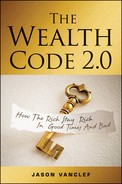Preface
A frog placed in a pot of boiling water will jump out and save itself. If that same frog is placed in the pot with cold water and heat is slowly applied, it will boil itself to death.
Running a wealth management firm in Los Angeles, California, I meet hundreds of people each year and discuss their finances. Nothing cuts more to the core than people and their money. With each passing year, as I see hard working people who have had their retirement goals shattered time and time again by the stock markets. I question, “Is the stock market just a big pot of water with the heat slowly being turned on?”
If this book was written in a year like 1999 or 2006, most people would disregard it. “The stock markets are great,” they would say. “It has made us a lot of money.” In spite of the terrible correction between 2000 and 2002, the sense that all was right was the prevailing belief. By 2006 most people were nowhere near the account value they had before the market crash, yet their faith in the market was unshakable. The heat was being applied to the pot of water, but most people stayed the course.
The timing of the first edition of The Wealth Code, mid 2009 and after the horrendous loss of wealth suffered with the stock market crash between 2007 and 2009, was no accident. I felt people needed to be shaken up before they could be open to a different viewpoint on building and protecting their nest eggs.
My goal was to educate investors on how using financial building blocks other than just stocks and bonds could provide the potential for more consistent returns and cash flow for their retirements. These other building blocks include investments such as Oil/Gas, Equipment Leases, Collateralized Notes, Real Estate, and many more. Financial ideas common to the super wealthy but generally not thought of as being accessible to the regular investor in a 401(k) plan or in their personal savings.
“Representing ideas of wealth, not Wall Street,” has been a common saying to my clients for years now.
The objective of this second edition is to further expand the ideas, applying lessons learned in the last three years since the first edition was published, and more importantly to give people a new perspective and more control over their finances. After experiencing 12 years in the current bear market which began in 2000, most people are beginning to realize that maybe the water pot is not the best place for their money, and the revolt against staying the course has begun.
Jason Vanclef
December 2012
